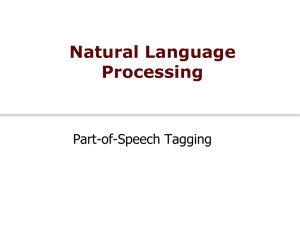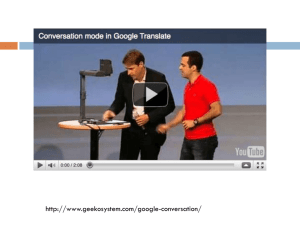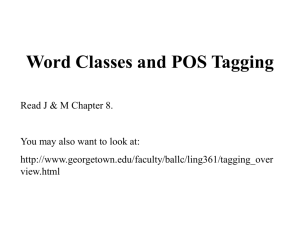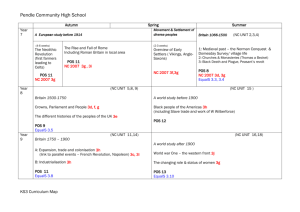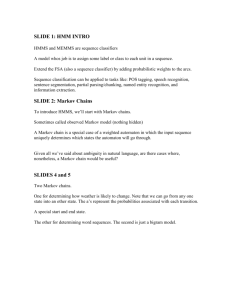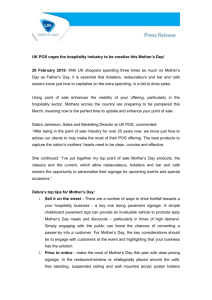Corpus Annotation for Computational Linguistics
advertisement
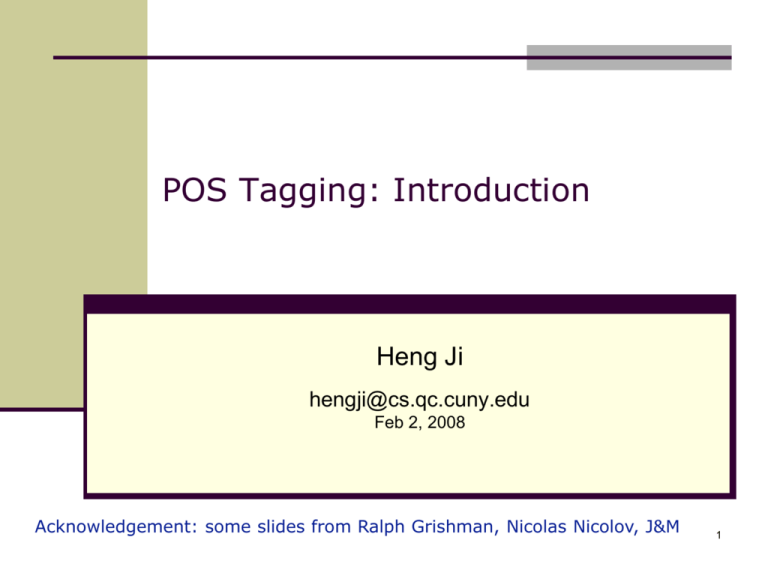
POS Tagging: Introduction Heng Ji hengji@cs.qc.cuny.edu Feb 2, 2008 Acknowledgement: some slides from Ralph Grishman, Nicolas Nicolov, J&M 1 Some Administrative Stuff Assignment 1 due on Feb 17 Textbook: required for assignments and final exam 2/39 Outline Parts of speech (POS) Tagsets POS Tagging Rule-based tagging Markup Format Open source Toolkits 3/39 What is Part-of-Speech (POS) Generally speaking, Word Classes (=POS) : Verb, Noun, Adjective, Adverb, Article, … We can also include inflection: Verbs: Tense, number, … Nouns: Number, proper/common, … Adjectives: comparative, superlative, … … 4/39 Parts of Speech 8 (ish) traditional parts of speech Noun, verb, adjective, preposition, adverb, article, interjection, pronoun, conjunction, etc Called: parts-of-speech, lexical categories, word classes, morphological classes, lexical tags... Lots of debate within linguistics about the number, nature, and universality of these We’ll completely ignore this debate. 5/39 7 Traditional POS Categories N V ADJ ADV P PRO DET noun chair, bandwidth, pacing verb study, debate, munch adj purple, tall, ridiculous adverb unfortunately, slowly, preposition of, by, to pronoun I, me, mine determiner the, a, that, those 6/39 POS Tagging The process of assigning a part-of-speech or lexical class marker to each word in a WORD collection. the koala put the keys on the table tag DET N V DET N P DET N 7/39 Penn TreeBank POS Tag Set Penn Treebank: hand-annotated corpus of Wall Street Journal, 1M words 46 tags Some particularities: to /TO not disambiguated Auxiliaries and verbs not distinguished 8/39 Penn Treebank Tagset 9/39 Why POS tagging is useful? Speech synthesis: How to pronounce “lead”? INsult inSULT OBject obJECT OVERflow overFLOW DIScount disCOUNT CONtent conTENT Stemming for information retrieval Can search for “aardvarks” get “aardvark” Parsing and speech recognition and etc Possessive pronouns (my, your, her) followed by nouns Personal pronouns (I, you, he) likely to be followed by verbs Need to know if a word is an N or V before you can parse Information extraction Finding names, relations, etc. Machine Translation 10/39 Equivalent Problem in Bioinformatics Durbin et al. Biological Sequence Analysis, Cambridge University Press. Several applications, e.g. proteins From primary structure ATCPLELLLD Infer secondary structure HHHBBBBBC.. 11/39 Why is POS Tagging Useful? First step of a vast number of practical tasks Speech synthesis How to pronounce “lead”? INsult inSULT OBject obJECT OVERflow overFLOW DIScount disCOUNT CONtent conTENT Parsing Need to know if a word is an N or V before you can parse Information extraction Finding names, relations, etc. Machine Translation 12/39 Open and Closed Classes Closed class: a small fixed membership Prepositions: of, in, by, … Auxiliaries: may, can, will had, been, … Pronouns: I, you, she, mine, his, them, … Usually function words (short common words which play a role in grammar) Open class: new ones can be created all the time English has 4: Nouns, Verbs, Adjectives, Adverbs Many languages have these 4, but not all! 13/39 Open Class Words Nouns Proper nouns (Boulder, Granby, Eli Manning) English capitalizes these. Common nouns (the rest). Count nouns and mass nouns Count: have plurals, get counted: goat/goats, one goat, two goats Mass: don’t get counted (snow, salt, communism) (*two snows) Adverbs: tend to modify things Unfortunately, John walked home extremely slowly yesterday Directional/locative adverbs (here,home, downhill) Degree adverbs (extremely, very, somewhat) Manner adverbs (slowly, slinkily, delicately) Verbs In English, have morphological affixes (eat/eats/eaten) 14/39 Closed Class Words Examples: prepositions: on, under, over, … particles: up, down, on, off, … determiners: a, an, the, … pronouns: she, who, I, .. conjunctions: and, but, or, … auxiliary verbs: can, may should, … numerals: one, two, three, third, … 15/39 Prepositions from CELEX 16/39 English Particles 17/39 Conjunctions 18/39 POS Tagging Choosing a Tagset There are so many parts of speech, potential distinctions we can draw To do POS tagging, we need to choose a standard set of tags to work with Could pick very coarse tagsets N, V, Adj, Adv. More commonly used set is finer grained, the “Penn TreeBank tagset”, 45 tags PRP$, WRB, WP$, VBG Even more fine-grained tagsets exist 19/39 Using the Penn Tagset The/DT grand/JJ jury/NN commmented/VBD on/IN a/DT number/NN of/IN other/JJ topics/NNS ./. Prepositions and subordinating conjunctions marked IN (“although/IN I/PRP..”) Except the preposition/complementizer “to” is just marked “TO”. 20/39 POS Tagging Words often have more than one POS: back The back door = JJ On my back = NN Win the voters back = RB Promised to back the bill = VB The POS tagging problem is to determine the POS tag for a particular instance of a word. These examples from Dekang Lin 21/39 How Hard is POS Tagging? Measuring Ambiguity 22/39 Current Performance How many tags are correct? About 97% currently But baseline is already 90% Baseline algorithm: Tag every word with its most frequent tag Tag unknown words as nouns How well do people do? 23/39 Quick Test: Agreement? the students went to class plays well with others fruit flies like a banana DT: the, this, that NN: noun VB: verb P: prepostion ADV: adverb 24/39 Quick Test the students went to class DT NN VB P NN plays well with others VB ADV P NN NN NN P DT fruit flies like a banana NN NN VB DT NN NN VB P DT NN NN NN P DT NN NN VB VB DT NN 25/39 How to do it? History Trigram Tagger (Kempe) 96%+ DeRose/Church Efficient HMM Sparse Data 95%+ Greene and Rubin Rule Based - 70% 1960 Brown Corpus Created (EN-US) 1 Million Words HMM Tagging (CLAWS) 93%-95% 1970 Brown Corpus Tagged LOB Corpus Created (EN-UK) 1 Million Words Tree-Based Statistics (Helmut Shmid) Rule Based – 96%+ Transformation Based Tagging (Eric Brill) Rule Based – 95%+ 1980 Combined Methods 98%+ Neural Network 96%+ 1990 2000 LOB Corpus Tagged POS Tagging separated from other NLP British National Corpus (tagged by CLAWS) Penn Treebank Corpus (WSJ, 4.5M) 26/39 Two Methods for POS Tagging 1. Rule-based tagging (ENGTWOL) 2. Stochastic 1. Probabilistic sequence models HMM (Hidden Markov Model) tagging MEMMs (Maximum Entropy Markov Models) 27/39 Rule-Based Tagging Start with a dictionary Assign all possible tags to words from the dictionary Write rules by hand to selectively remove tags Leaving the correct tag for each word. 28/39 Rule-based taggers Early POS taggers all hand-coded Most of these (Harris, 1962; Greene and Rubin, 1971) and the best of the recent ones, ENGTWOL (Voutilainen, 1995) based on a two-stage architecture Stage 1: look up word in lexicon to give list of potential POSs Stage 2: Apply rules which certify or disallow tag sequences Rules originally handwritten; more recently Machine Learning methods can be used 29/39 Start With a Dictionary • she: PRP • promised: VBN,VBD • to TO • back: VB, JJ, RB, NN • the: DT • bill: NN, VB • Etc… for the ~100,000 words of English with more than 1 tag 30/39 Assign Every Possible Tag NN RB VBN JJ VB PRP VBD TO VB DT NN She promised to back the bill 31/39 Write Rules to Eliminate Tags Eliminate VBN if VBD is an option when VBN|VBD follows “<start> PRP” NN RB VBN JJ VB PRP VBD TO VB DT NN She promised to back the bill 32/39 Stage 1 of ENGTWOL Tagging First Stage: Run words through FST morphological analyzer to get all parts of speech. Example: Pavlov had shown that salivation … Pavlov had shown that salivation PAVLOV N NOM SG PROPER HAVE V PAST VFIN SVO HAVE PCP2 SVO SHOW PCP2 SVOO SVO SV ADV PRON DEM SG DET CENTRAL DEM SG CS N NOM SG 33/39 Stage 2 of ENGTWOL Tagging Second Stage: Apply NEGATIVE constraints. Example: Adverbial “that” rule Eliminates all readings of “that” except the one in “It isn’t that odd” Given input: “that” If (+1 A/ADV/QUANT) ;if next word is adj/adv/quantifier (+2 SENT-LIM) ;following which is E-O-S (NOT -1 SVOC/A) ; and the previous word is not a ; verb like “consider” which ; allows adjective complements ; in “I consider that odd” Then eliminate non-ADV tags Else eliminate ADV 34/39 Inline Mark-up POS Tagging http://nlp.cs.qc.cuny.edu/wsj_pos.zip Input Format Pierre Vinken, 61/CD years/NNS old , will join the board as a nonexecutive director Nov. 29. Output Format Pierre/NNP Vinken/NNP ,/, 61/CD years/NNS old/JJ ,/, will/MD join/VB the/DT board/NN as/IN a/DT nonexecutive/JJ director/NN Nov./NNP 29/CD ./. 35/39 POS Tagging Tools NYU Prof. Ralph Grishman’s HMM POS tagger (in Java) http://nlp.cs.qc.cuny.edu/jet.zip http://nlp.cs.qc.cuny.edu/jet_src.zip http://www.cs.nyu.edu/cs/faculty/grishman/jet/license.html Demo How it works: Learned HMM: data/pos_hmm.txt Source code: src/jet/HMM/HMMTagger.java 36/39 POS Tagging Tools Stanford tagger (Loglinear tagger ) http://nlp.stanford.edu/software/tagger.shtml Brill tagger http://www.tech.plym.ac.uk/soc/staff/guidbugm/software/RULE_B ASED_TAGGER_V.1.14.tar.Z tagger LEXICON test BIGRAMS LEXICALRULEFULE CONTEXTUALRULEFILE YamCha (SVM) http://chasen.org/~taku/software/yamcha/ MXPOST (Maximum Entropy) ftp://ftp.cis.upenn.edu/pub/adwait/jmx/ More complete list at: http://www-nlp.stanford.edu/links/statnlp.html#Taggers 37/39 NLP Toolkits Uniform CL Annotation Platform UIMA (IBM NLP platform): http://incubator.apache.org/uima/svn.html Mallet (UMASS): http://mallet.cs.umass.edu/index.php/Main_Page MinorThird (CMU): http://minorthird.sourceforge.net/ NLTK: http://nltk.sourceforge.net/ Natural langauge toolkit, with data sets Demo Information Extraction Jet (NYU IE toolkit) http://www.cs.nyu.edu/cs/faculty/grishman/jet/license.html Gate: http://gate.ac.uk/download/index.html University of Sheffield IE toolkit Information Retrieval INDRI: http://www.lemurproject.org/indri/ Information Retrieval toolkit Machine Translation Compara: http://adamastor.linguateca.pt/COMPARA/Welcome.html ISI decoder: http://www.isi.edu/licensed-sw/rewrite-decoder/ MOSES: http://www.statmt.org/moses/ 38/39 Looking Ahead: Next Class Machine Learning for POS Tagging: Hidden Markov Model 39/39
